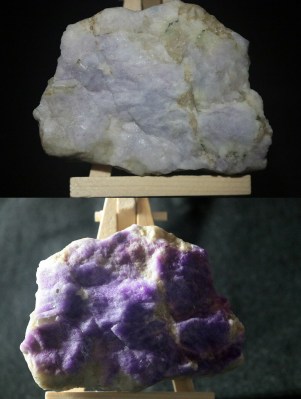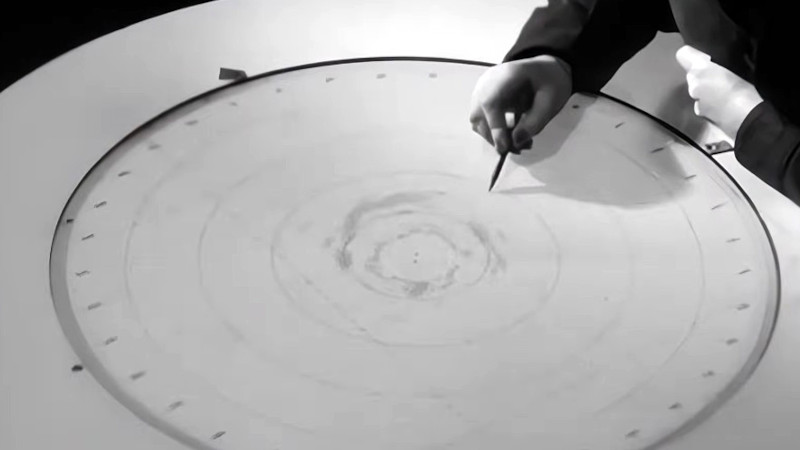When you’ve been a fact-sponge for electronics trivia for over four decades, it’s not often that an entire class of parts escapes your attention. But have you seen the Skiatron? It’s a CRT that looks like a normal mid-20th-century tube, until it’s switched on. Then its secret is revealed; instead of the glowing phosphor trace we’d expect, the paper-white screen displays a daylight-readable and persistent black trace. They’re invariably seen in videos of radar installations, with the 360 degree scans projected onto large table-top screens which show the action like a map. It’s like e-ink, but from the 1940s. What’s going on?

The phosphor coating on a traditional CRT screen is replaced by a halide salt, and the property on which the display relies is called tenebrescence, changing colour under the influence of radiation. This seems most associated online with UV treatment of some minerals and gemstones to give them a prettier look, and its use a s a display technology is sadly forgotten.
A high-school physics understanding of the phenomenon is that energy from the UV light or the electron beam in the case of the tube, places some electrons in the crystal into higher energy levels, at which they absorb some visible light wavelengths. This is reversible through heat, in some substances requiring the application of heat while in others the heat of room temperature being enough. Of course here at Hackaday we’re hands-on people, so into the EPROM eraser went a small amount of table salt in a makeshift dish made of paper, but sadly not to be rewarded by a colour change.
On a real dark-trace CRT the dark trace would be illuminated from behind by a ring light round the glass neck of the tube. An interesting aside is that, unlike phosphor CRTs, they were more suitable for vertical mounting. It seems that small amounts of phosphor could detach themselves from a vertically mounted screen and drop into the electron gun, something that wasn’t a problem for tenebrescent coatings.
This display tech has shuffled off into the graveyard of obsolescence, we’re guessing because CRT technology became a lot better over the 1950s, and radar technologies moved towards a computerised future in which the persistence of the display wasn’t the only thing keeping the information on the screen. It seems at first sight to be a surprise that tenebrescent coatings have never resurfaced in other displays for their persistence, but perhaps there was always a better alternative whether it was ultra-low-power LCDs or more recently e-ink style devices.
For more bleeding-edge 1950s radar displays, we’ve previously brought you Volscan, a radar with an early form of GUI, which no doubt was one of those which consigned dark-trace CRTs to history.

















the photochromic sunglasses of the 70’s come to mind
Dicomed made a 1k X 1k display that I used throught graduate school at Cornell, 1970-75. It was the best available persistant display of the time and it worked reliably for all my projects!
“An interesting aside is that, unlike phosphor CRTs, they were more suitable for vertical mounting…”
I doubt that. Early TV sets were often built with the tube mounted face-up and viewed through a mirror, because “large” screen tubes were too long to be mounted horizontally. The British Admiralty skiatron set shown is probably a rear projection unit. Building a picture tube of that size with a flat screen would have been next to impossible back then and still is a challenge today. Also the skiatron needs strong external irradiation for erasure, not exactly practical with a drawing table, but easy to combine with an episcope projector.
Didn’t those vertical tubes have the display in the bottom and the gun in the top though?
That would have been somewhat impractical for a mirror lid set.
Look here: https://www.earlytelevision.org/rca_trk-12.html
Most 12″ and larger sets before 1940 were built that way.
Cool TV set!
I’m a longtime member of the Tube Collector’s Association as well as a semi-expert on obscure tubes. For what little it’s worth, WWII skiatrons were used only in special rear-projection displays for radar direction centers, in the field or on ships. The 4AP10 was the most common type. It was slow to write a mark on the “scotophor” screen, and I mean S L O W. Erasing the screen took 10-20 minutes and required literally heating the entire tube, so it was very limited in application.
https://www.sm5cbw.se/tubes/htm/4ap10.htm
After the war 4AP10s were dirt-common surplus at absurdly low prices because no one could find another valid use for them. A few experimental types were made for storage oscilloscopes but the absurdly long erase time was a serious disadvantage.
https://tubetime.us/index.php/2014/06/09/p10-dark-phosphor-the-skiatron/
Today collectors fight over 4AP10s in auctions–I’ve personally seen it happen. It took 70+ years for the things to become scarce and weird enough.
“a s a”?
“Hackmanite” is hereby nominated for adoption as “The Official Mineral of Hackaday.com”.
I second the motion.
I third it. Move to put into production.
Can I fourth it? I’ll let someone else take the fifth. 😂
And may as well second the move to put into production. 🖖😎
Sixth for production production of production
I dig it.
Is this hackmantite a day or something?!
Hackmanite is a member of the sodalite family. https://www.gemrockauctions.com/learn/a-z-of-gemstones/hackmanite-information
I prefer full sugar sodas over the lite soda varieties.
9 out of 10 Dentists prefer Sodalite
Okay, if this was a joke, I’m afraid I’m slow sometimes. But it’s hilarious. Thank you for that.
So now all other minerals can just be referred to as Not-a-Hackmanite?
+10!!
Whenever I see that “mother of all demos” video from (the 1960s?), I wonder what display they were using – it looks like a vector display, only it’s dark lines on a light background.
At first I thought perhaps this was the answer, but clearly a skiatron couldn’t show animated graphics. I guess it’s more likely a regular CRT and they inverted the video recording.
A paper-like vector tube display would be pretty cool though. I guess these days you could use a galvo with a UV laser to write and an infrared laser to erase, though it still wouldn’t be super fast…
Depending on screen size, that was either a CRT-based projector or for really big screens, an Eidophor. NASA used Eidophors in their control room and also some universities had them.
It was an Eidophor, Engelbart said so during the acknowledgements at the end, thanking the organization who loaned it out for the presentation.
1:37:43 into the presentation
If you want to read more: https://hackaday.com/2016/03/15/retrotechtacular-eidophor-an-unknown-widely-used-projector/
Does this effect have any relation to why some clear glass from the 1910’s and earlier slowly and permanently turns purple in sunlight?
No, it is because life was all black and white before Technicolor.
B^)
All I could afford was sepia.
So we have had the technology to build DEDs (Dark Emitting Diodes) all along!
Handy for “lighting” dystopian scenes everywhere.
We also have technology for SEDs, smoke-emitting diodes.
Surprisingly popular in high-power electronics.
I have used quite a few FET’s (fragment emitting transistors). Being write once was an unfortunate limitation.
This specimen is sensitive enough that even exposure to the sun causes strong tenebrescence.
You can view a gallery of this specimen with photos, and see it illuminated under UV light of all frequencies, including great phosphorescence:
https://www.flickr.com/photos/lelandgreen/albums/72157709638643216